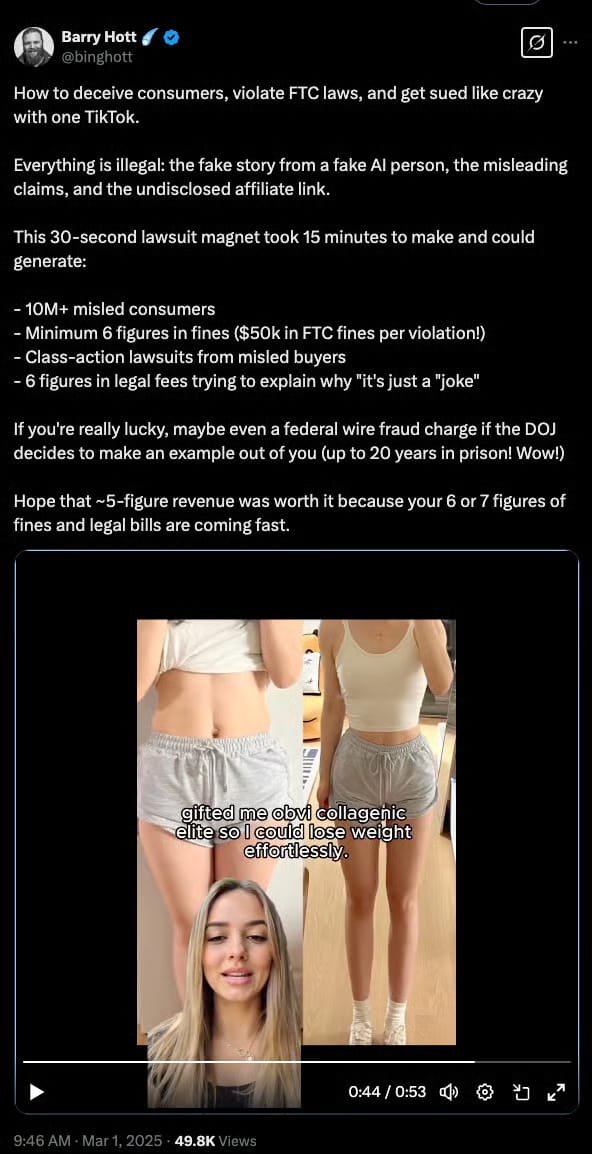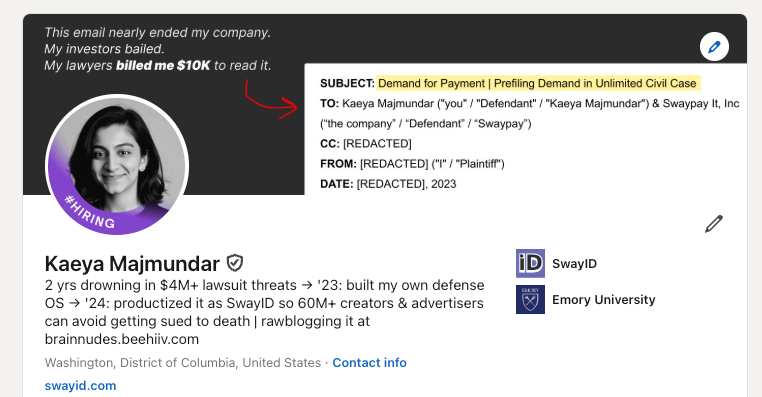- brain nudes
- Posts
- DEMAND FOR PAYMENT
DEMAND FOR PAYMENT

The Downside of Everything
In an AI-native world, the highs are real.
Faster builds. Instant feedback loops. Scaled output.
But so are the lows.
The faster you move, the more exposed you are.
Case In Point:
(More detail on this here)

If you’re chasing the upside — vibe coding, vibe posting, chasing speed and momentum — you better be anchored to a base layer of protection underneath it.
Because one day, inevitably — like me — you’ll wake up to an email with a subject line like this:

🟥 DEMAND FOR PAYMENT
🟨 Prefiling Demand in Unlimited Civil Case
That email could’ve ended my company.
My investors bailed.
My lawyers billed me $10K just to read it.
But by then, I had already built the system that saved me.
Structured proof. Public records. Defense-first architecture.
So when I get those emails now, I sleep like a baby.
Because that’s what SwayID is.
Pop it into your stack and sleep better.
There’s a certain kind of AI product you forget you’re even using — not because it’s invisible, but because it eliminates the kind of friction that used to keep you up at night.
SwayID is that kind of product.
Not a wrapper. Not a weekend demo. Not a hot filter on top of a hot model. But a deeply integrated, AI-native system that makes an entirely new kind of outcome possible: automated, timestamped, public compliance defense for the most legally exposed layer of the internet — user-generated content.
Why This Couldn’t Have Existed Before
Before LLMs, structured compliance for influencer and creator campaigns was either:
– prohibitively manual (legal teams reviewing screenshots),
– unreliable (creators forgetting to disclose properly),
– or non-existent (most brands pretending it wasn’t their problem).
SwayID changed that — not by bolting GPT onto a dashboard, but by rethinking what a defense system could be.
With a blend of real-time content scanning, agentic logic around disclosure rules, and proof collection tied to identity and time, SwayID made something newly possible: proactive class action–immunization of a brand’s entire creator marketing layer.
Key Distinction: It’s not FTC-proof. It’s deceptive advertising lawsuit–resilient.
Just like a COVID vaccine doesn’t guarantee you won’t get infected, SwayID doesn’t promise that non-compliant UGC will never happen.
User-generated content is made by humans, and humans make mistakes.
The risk isn’t if someone messes up.
It’s what happens when they do.
With SwayID, here’s what happens:
There’s structured proof of good faith.
There’s a record of consistent disclosure logic.
There’s public commitment to compliance: visible, timestamped, and defensible.
If you're advertising through UGC in 2025, exposure isn’t a risk. It’s a given.
Immunization doesn’t eliminate the threat.
It ensures you survive it and flip the legal narrative when it matters most.
This isn’t just alerting. It’s not just analytics.
It’s the legal equivalent of a seatbelt: semi-automatic, unintrusive, and increasingly expected.
What Makes It “AI-Native”
If you stripped out the AI, the product wouldn’t work. That’s the bar.
The core defense loop of SwayID requires:
LLMs to interpret language across thousands of variations of disclosures
agentic memory to track a brand’s unique operating patterns
multimodal inputs to process video overlays, audio callouts, and on-screen disclaimers
contextual nuance to distinguish between compliant vs. risky phrasing, even when embedded in slang, sarcasm, or brand-speak
This isn’t a UI slapped on top of ChatGPT. It’s a system designed for what only today’s models can do and what they couldn’t do even 12 months ago.
The Workload Transfer is the Point
One of the most defining traits of any defensible AI product is this: it reduces effort without reducing confidence.
Most brands live in a weird limbo right now, they know they’re legally liable for what their creators post, but they can’t possibly vet every story, TikTok, or affiliate page.
So they either over-lawyer or under-protect.
SwayID transfers that work to a system that:
watches passively
flags intelligently
collects proof continuously
and gets smarter with every campaign
It doesn’t ask the user to do more.
It asks them to do things differently — not harder, but smarter — so the system can continuously generate proof, not just surface alerts.
From Vibes to Verdicts
“Vibes” might be the new buzzword in the startup world but in the legal world, vibes get you sued.
The consumer layer of the internet is full of them.
Aesthetic. Tone. Intuition. Intent.
What people now call “vibe coding” — building fast, loose, and emotionally, without learning the technical systems underneath — is glorified as momentum and democratized access.
And on the creator side, we’re seeing the same pattern emerge:
“Vibe content creation” — using AI tools to pump out endless UGC ads with no understanding of legal bounds, foundational ad hygiene, or disclosure rules.
But here’s the problem:
If you’re vibe coding — or vibe posting as a TikTok affiliate — and you’re not keeping a clean record of how you’re acting in good faith to avoid deceiving consumers, or why you’re doing what you’re doing, you’re fucked.
In engineering, that leads to tech debt.
In creator marketing, it leads to lawsuits.
Because vibes are the opposite of intentionality.
So when a brand’s defense hinges on vibes, it’s inherently lacking structured proof of work. It’s starting off on the back foot.
Vibes aren’t just weak. They’re lawsuit bait.
Right now, the FTC can fine you $43,792 per violation if your influencer posts don’t meet their standards. That’s not hypothetical.
That’s the enforcement reality.
SwayID doesn’t just interpret risk. It logs it.
Time-stamped. Public. Provable. And increasingly court-tested.
It’s not a feature.
It’s not a dashboard.
It’s a shield, one you don’t have to remember to pick up.
The Moat Is Trust
There’s no moat in building the 10th compliance SaaS dashboard this year. But there is a moat in:
structured proof generation
public accountability rails
real-world legal survivability
and a trust layer that scales
The more users rely on SwayID, the stronger the signal loops get — not just around compliance, but around the behaviors that predict exposure.
It’s not a black box. It’s a memory. And that memory becomes its own moat.
Why SwayID Users Sleep Better
We’ve experienced this firsthand:
– Founders hit with lawsuits over what their creators posted
– Influencers sued for content they didn’t realize was non-compliant
– CMOs handed legal firestorms with no standardized hygiene protocols in place
– CFOs staring down seven-figure legal bills — as lawyers scramble to build a defense with no logs, no proof, no record of good faith to draw from
After plugging into SwayID, they started building that record — proactively, in real time.
A system of record that holds up to scrutiny.
A shared system that protects brands, agencies, and creators alike.
A record that helps everyone sleep at night.
-Kaeya
PS: we’re hiring